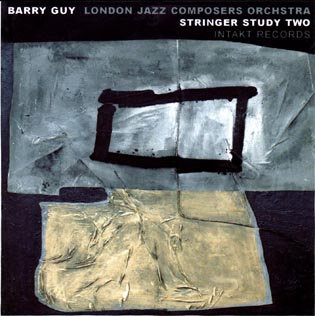BARRY GUY
LONDON JAZZ COMPOSERS ORCHESTRA
Study II, Stringer
Intakt CD 095

STUDY II
Barry Guy - bass, director
Irène Schweizer - piano
Henry Lowther, Marc Charig, Jon Corbett - trumpet
Conrad Bauer, Radu Malfatti, Alan Tomlinson - trombone
Steve Wick - tuba
Trevor Watts, Evan Parker, Simon Picard, Paul Dunmall - reeds
Peter McPhail - reeds/flute
Philipp Wachsmann - violin
Barre Phillips - bass
Paul Lytton - percussion
Recorded February, 2, 1991, Radio Studio DRS, Zürich.
Engineer: Peter Pfister. © Intakt Records, Zürich
STRINGER (FOUR PIECES FOR ORCHESTRA)
Kenny Wheeler, Harry Beckett, Dave Spence - trumpet and flugelhorn
Paul Rutherford, Alan Tomlinson, Paul Nieman - trombone
Melvin Poore - tuba
Trevor Watts, Evan Parker, Peter Brötzmann Larry Stabbins, Tony Coe -
saxophone and clarinet
Philipp Wachsmann - violin
Howard Riley - piano
Tony Oxley, John Stevens - percussion
Barry Guy, Peter Kowald - bass
Recorded March, 26, 1980 at the Maida Vale Studio, BBC
First Released as FMP LP, 1983 by Jost Gebers
© Intakt Records, Zürich
MAILORDER-PRICE:
Schweiz: 30 SFr. plus 3 SFr. Porto
Deutschland/Österreich: 18 Euro plus 2.50 Euro Porto/Versand
International: VISA / MASTER: 30 SFr. plus 4 SFr. Postage
Order adress:
Intakt Records, Postfach 468, 8024 Zürich
intakt@intaktrec.ch
Fax: 0041-1-383 82 33
|
Zwei
wichtige Werke von Barry Guy, aufgeführt mit dem London Jazz Composers
Orchestra, sind auf dieser CD zu hören. Stringer als Re-Release
einer bei FMP erschienenen und
The history
of Barry Guy's Jazz Composers’ Orchestra begins in 1970 with Ode,
the first manifesto of this new way of individual/ collective collaboration
at the interface of a structured intervention and the freedom of improvising.
Ten years later, after from a stylistic point of view pluralistic beginnings,
a work of equal significance has been created: Stringer. The orchestra
has found its language, The musicians breathe the newly gained freedom
in different playing combinations of solo high points and collective
complexity. |
Liner Notes of Bert Noglik: Study II, Stringer